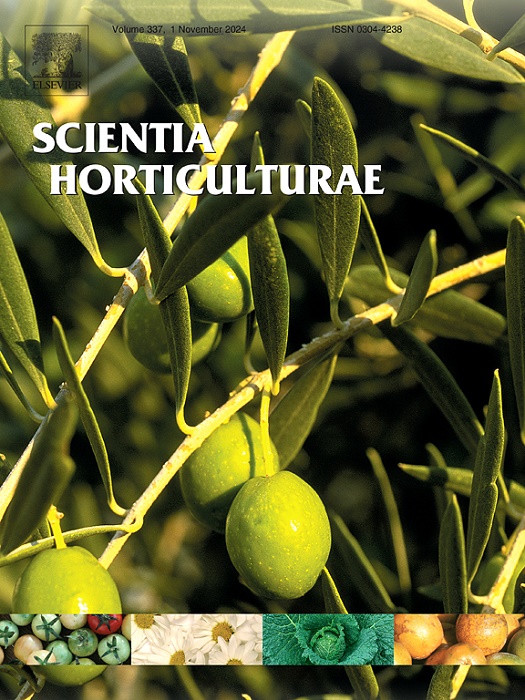比较生理学和转录组学分析揭示了春兰红叶形成的机制
IF 3.9
2区 农林科学
Q1 HORTICULTURE
引用次数: 0
摘要
色彩鲜艳的叶子,尤其是红色的叶子,是春兰重要的观赏特征。然而,红叶形成的机制尚不清楚。在这项研究中,我们研究了红绿叶在不同发育阶段的表型、生理和转录组学差异。我们发现,在各个阶段,红色叶片的叶绿素a、叶绿素b、类胡萝卜素和总叶绿素含量明显较低,而花青素含量明显较高。超微结构分析显示,红叶叶绿体结构异常,叶绿体数量减少,类囊体膜破裂,基质层模糊,亲锇颗粒堆积,导致光合能力降低。此外,转录组学分析显示,不同生长阶段红绿叶片花青素生物合成、叶绿素代谢和光合作用相关基因的表达存在显著差异。因此,我们认为红叶的形成是由于叶绿素代谢基因的表达减少,导致叶绿体发育和叶绿素合成受损,而花青素生物合成基因的上调促进了花青素的积累,导致了红叶的形成。这些研究结果对红叶的颜色形成机制提供了有价值的见解。本文章由计算机程序翻译,如有差异,请以英文原文为准。
Comparative physiology and transcriptome analysis revealed the mechanisms underlying red leaf formation in Cymbidium ensifolium
Colorful leaves, particularly red ones, represent an important ornamental trait of Cymbidium ensifolium. However, the mechanisms underlying red leaf formation in C. ensifolium are not well understood. In this study, we examined the phenotypic, physiological, and transcriptomic differences between red and green leaves at various developmental stages. We found that red leaves exhibited significantly lower levels of chlorophyll a, chlorophyll b, carotenoids, and total chlorophyll across all stages, while anthocyanin levels were notably higher. Ultrastructural analysis revealed abnormalities in the chloroplast structure of red leaves, including fewer chloroplasts, ruptured thylakoid membranes, an indistinct matrix layer, and the accumulation of osmiophilic particles, which led to reduced photosynthetic capacity. In addition, transcriptomic analysis showed significant differences in the expression of genes related to anthocyanin biosynthesis, chlorophyll metabolism, and photosynthesis between red and green leaves at different stages of growth. Therefore, we suggest that red leaf formation in C. ensifolium is driven by reduced expression of chlorophyll metabolism genes, resulting in impaired chloroplast development and chlorophyll synthesis, while upregulation of anthocyanin biosynthesis genes promotes anthocyanin accumulation, leading to the red coloration. These findings provide valuable insights into color formation mechanisms of red leaves in C. ensifolium.
求助全文
通过发布文献求助,成功后即可免费获取论文全文。
去求助
来源期刊

Scientia Horticulturae
农林科学-园艺
CiteScore
8.60
自引率
4.70%
发文量
796
审稿时长
47 days
期刊介绍:
Scientia Horticulturae is an international journal publishing research related to horticultural crops. Articles in the journal deal with open or protected production of vegetables, fruits, edible fungi and ornamentals under temperate, subtropical and tropical conditions. Papers in related areas (biochemistry, micropropagation, soil science, plant breeding, plant physiology, phytopathology, etc.) are considered, if they contain information of direct significance to horticulture. Papers on the technical aspects of horticulture (engineering, crop processing, storage, transport etc.) are accepted for publication only if they relate directly to the living product. In the case of plantation crops, those yielding a product that may be used fresh (e.g. tropical vegetables, citrus, bananas, and other fruits) will be considered, while those papers describing the processing of the product (e.g. rubber, tobacco, and quinine) will not. The scope of the journal includes all horticultural crops but does not include speciality crops such as, medicinal crops or forestry crops, such as bamboo. Basic molecular studies without any direct application in horticulture will not be considered for this journal.
 求助内容:
求助内容: 应助结果提醒方式:
应助结果提醒方式:


